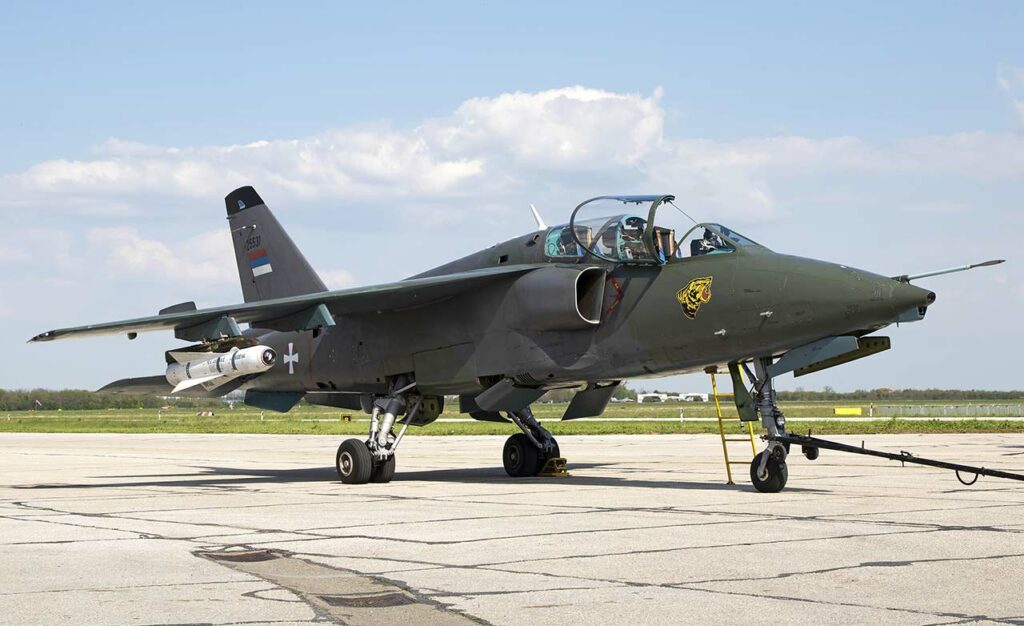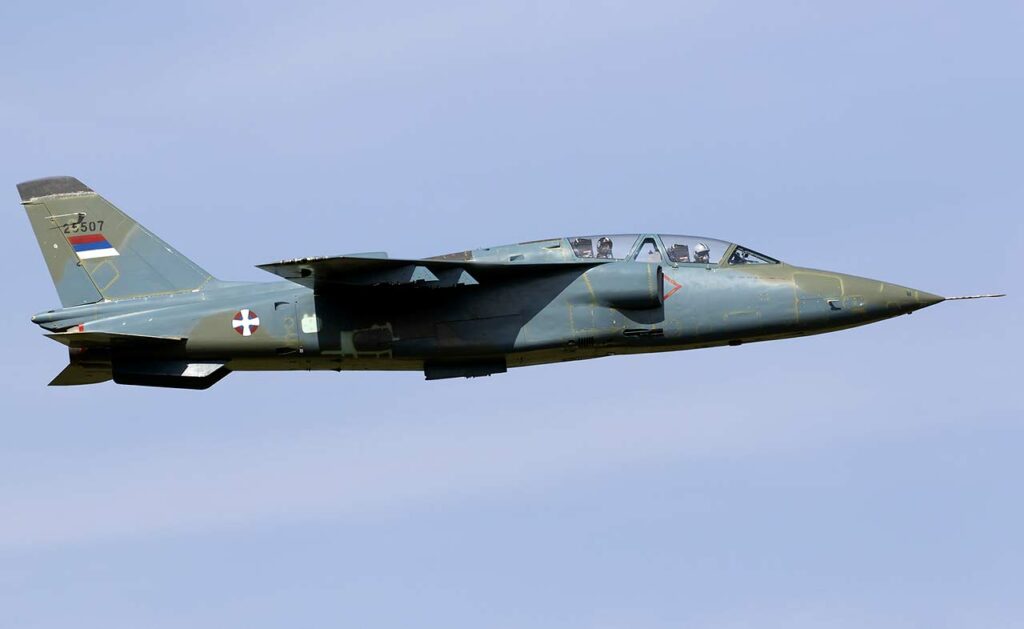Yugoslav-built SOKO J-22 Orao, a twin-engine, subsonic attack aircraft designed for ground support.
In brief
The SOKO J-22 Orao is a subsonic ground attack and reconnaissance aircraft developed jointly by Yugoslavia and Romania during the Cold War. Powered by two Rolls-Royce Viper Mk 633-47 turbojet engines, each providing a thrust of 4,000 pounds, the aircraft is capable of speeds up to 685 mph with a service ceiling of 33,000 feet. It has a maximum range of approximately 1,080 miles. The J-22’s design includes a tandem-seat cockpit, swept wings for stability at high speeds, and hardpoints capable of carrying a variety of weapons including bombs, rockets, and missiles. The aircraft’s robust construction and systems are suited for operations from forward airfields near combat zones.

History of the Development of the SOKO J-22 Orao
In the late 1960s, as tensions heightened in Europe during the Cold War, Yugoslavia sought to enhance its military independence and capabilities through domestic production of a versatile attack aircraft. This strategic move aimed to reduce reliance on foreign equipment and develop local industry. Consequently, Yugoslavia collaborated with Romania to design and produce an aircraft that met these operational needs, leading to the development of the SOKO J-22 Orao (Eagle).
The development program was initiated under the auspices of both countries’ national defense industries, with SOKO in Yugoslavia and Avioane Craiova in Romania taking the lead. This collaboration was part of a broader effort to foster technological exchange and cooperation within the Non-Aligned Movement. The prototype of the J-22 first flew on November 31, 1974, marking a significant milestone in Eastern European military aviation.
The aircraft was not assigned a NATO reporting name, largely due to its operation within the Warsaw Pact’s sphere but outside of direct NATO engagement or concern. The J-22 Orao was designed to perform multiple roles, including low-altitude day and night attack, reconnaissance, and tactical support, with the adaptability to carry a wide range of ordnance options.
Design of the SOKO J-22 Orao
The design of the SOKO J-22 Orao reflects its role as a durable and flexible attack aircraft. Measuring 13.25 meters in length with a wingspan of 9.30 meters, its airframe is optimized for agility and durability under combat conditions. The aircraft’s structure is built to withstand the stresses of low-altitude flight and short takeoff and landing capabilities, enabling operations from less prepared airfields.
The J-22 features a tandem-seat configuration, allowing a pilot and a weapons systems officer to operate advanced navigation and targeting systems effectively. This setup is critical for the complex low-level attack and reconnaissance missions it was designed to perform. The aircraft employs a swept-wing design, which provides better control and lift at high subsonic speeds, essential for its attack profile.
Equipped with two Rolls-Royce Viper turbojets, the Orao has a total thrust of 8,000 pounds, which is modest compared to Western counterparts but sufficient for the aircraft’s operational requirements. Its avionics suite, while not as advanced as those found in NATO aircraft of the same era, supports essential electronic warfare and countermeasures to enhance survivability in contested airspace.
However, the J-22’s performance is constrained by its engine power, limiting its payload capacity and speed compared to more modern aircraft. Despite these limitations, the Orao’s design successfully balances cost, performance, and maintenance demands, making it a practical choice for Yugoslavia’s defense needs.
Performance of the SOKO J-22 Orao
In terms of performance, the J-22 Orao reaches a top speed of 685 mph, with an operational range of 1,080 miles and a service ceiling of 33,000 feet. These characteristics make it capable of fulfilling its roles in a variety of operational contexts, from penetrating enemy defenses at low altitudes to conducting extended reconnaissance missions.
Compared to its contemporaries, such as the American A-10 Thunderbolt II or the Soviet Su-25 Frogfoot, the J-22 does not offer the same level of survivability or payload capacity. However, its speed and range are competitive, providing a balanced capability for nations with limited defense budgets or those not requiring the heavy ordnance loads of more specialized aircraft.
Variants of the SOKO J-22 Orao
The J-22 Orao has several variants, reflecting its dual-role capability and the evolving needs of its operators. The initial production model was soon followed by improved versions featuring enhanced avionics and weapon systems. Notable among these are the J-22B, an upgraded version with better navigation and attack systems, and the NJ-22, a training variant with dual controls and reduced armament capacity.

Military Use and Combat of the SOKO J-22 Orao
The J-22 Orao saw combat during the Yugoslav Wars, where it was used primarily for ground attack missions against enemy troop concentrations and armored vehicles. Its operations demonstrated the aircraft’s effectiveness in close air support and interdiction roles, leveraging its robust design and weapon systems. The Orao was able to operate under challenging conditions, including operations from damaged or makeshift runways, showcasing its utility in asymmetric warfare scenarios.
Despite facing more advanced air defenses and competing against more modern aircraft, the J-22 performed credibly. Its service record includes participation in several key offensives, where it provided crucial support to ground operations. The aircraft remains in limited service with Serbia, continuing to fulfill a niche role within its air force capabilities.
The SOKO J-22 Orao represents a significant achievement in Eastern Bloc military aviation, exemplifying a successful indigenous approach to combat aircraft design and production. While it may not match the high-end performance of more modern aircraft, its versatility and robustness make it a valuable asset for countries needing a cost-effective solution to ground attack and reconnaissance challenges.
Back to the Fighter Jet section.